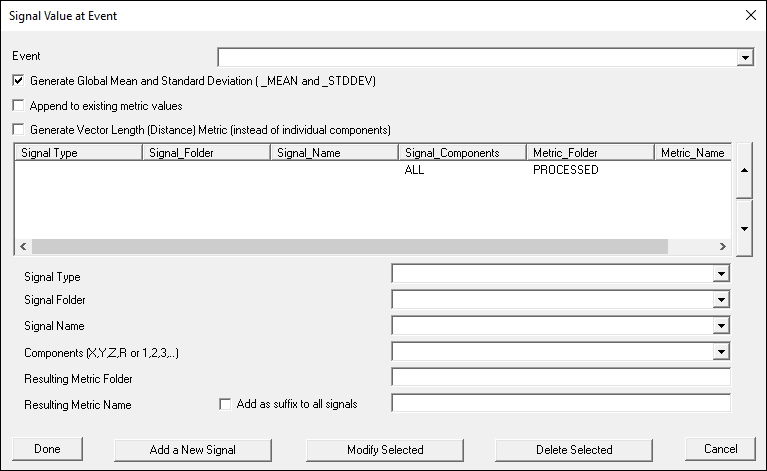Metric Signal Value At Event
| Language: | English • français • italiano • português • español |
|---|
Legacy Command
Metric_Signal_At_Event replaced the command Signal_Value_At_Event
Description
The value of the specified signal at the specified frame of data is stored as a metric.
- All components of the specified signal will be stored in the metric signal.
- Since version 5: the user has the option to select an individual component
- If there are multiple occurrences of an EVENT, there will be multiple entries in the metric that is created.
- There is an option to calculate the mean and standard deviation for metrics that have multiple values.
| Metric_Signal_Value_At_Event | |
| /Result_Metric_Name= | The name of the resulting signal. |
| /Result_Metric_Folder= | The folder that will contain the resulting signal |
| /Signal_Types= | The type of signal to be evaluated |
| /Signal_Names= | The names of the signals to be evaluated |
| /Signal_Folder= | The name of the signal folder |
| /Event_Name= | The name of the event Label. |
| /Generate_Mean_And_Stddev= | If there are multiple occurences of the Event, the metric will contain multiple values.If Selecte the mean and standard deviation for the metric values will be computed. |
| /Append_To_Existing_Values= | (True or False) If the metric exists, the new values will be appended to the metric, retaining all of the previous values. |
| /Generate_Metric_Length_Metric= | (True or False) If the metric is a vector quantity (e.g. has 3 components), compute the magnitude of the vector. |
| /Retain_No_Data_Values= | (True or False) If the result is no_data, retain the value. |
Example Value of a Target
This example calculates the value of the TARGET RFT1 at the Event_Label RON
- Metric_Signal_Value_At_Event
- /Result_Metric_Name=RFT1_ON
- /Result_Metric_Folder=PROCESSED
- /Signal_Types=TARGET
- /Signal_Names=RFT1
- /Signal_Folder=ORIGINAL
- /Event_Name=RON
- /Generate_Mean_And_Stddev=FALSE
- /Append_To_Existing_Values=FALSE
- /Generate_Metric_Length_Metric=FALSE
- /Retain_No_Data_Values=TRUE
- ;
Note: In cases where there is NO_DATA at an event, you need to specify the parameter /Retain_No_Data_Values=TRUE should you want this included in the resulting signal.
Example Time at an Event
This example calculates the time of the Event_Label RON
- Metric_Signal_Value_At_Event
- /Result_Metric_Name=RON_TIME
- /Result_Metric_Folder=PROCESSED
- /Signal_Types=FRAME_NUMBERS
- /Signal_Names=TIME
- /Signal_Folder=ORIGINAL
- /Event_Name=RON
- /Generate_Mean_And_Stddev=FALSE
- /Append_To_Existing_Values=FALSE
- /Generate_Metric_Length_Metric=FALSE
- /Retain_No_Data_Values=FALSE
- ;
Component Workaround
Since Metric_Signal_Value_At_Event outputs all three components, here is a workaround of the previous example that will output one component. Evaluate_Expression is used to create a signal with one component, the z component for RFT1. Then the Metric_Signal_Value_At_Event will calculate the value of the TARGET RFT1 at the Event_Label RON.
! RFT1 Z component Evaluate_Expression /Expression=TARGET::ORIGINAL::RFT1::Z /Result_Name=RFT1_Z /Result_Type=DERIVED /Result_Folder=ORIGINAL ; Metric_Signal_Value_At_Event /Result_Metric_Name=RFT1_ON /Result_Metric_Folder=PROCESSED /Signal_Types=DERIVED /Signal_Names=RFT1_Z /Signal_Folder=ORIGINAL /Event_Name=RON /Generate_Mean_And_Stddev=FALSE /Append_To_Existing_Values=FALSE /Generate_Metric_Length_Metric=FALSE /Retain_No_Data_Values=TRUE ;
P2D Signals
- Consider a P2D signal created using Global_Normalized_Signal_Mean.
- The resulting signal has three components, an index, a mean signals, and a standard deviation signal
- It is possible to compute the maximum value of the 3 components using Metric_Maximum
- It isn't possible to directly identify the standard deviation at that index because it isn't possible to define an Event for a time normalized signal (e.g.it has no frame rate or time.
- Without having an event you cannot get the value of a signal at that event using Metric_Signal_Value_At_Event
- One solution, albeit a non-intuitive solution is to SORT (descending) the p2D signal by the second component (eg. the MEAN).
- Evaluate_Expression
- /EXPRESSION=SORT(P2D::TEST::LHIP_ANGLE, -1.0, 2)
- ! /SIGNAL_TYPES=
- ! /SIGNAL_FOLDER=ORIGINAL
- ! /SIGNAL_NAMES=
- /RESULT_TYPES=P2D
- /RESULT_FOLDERS=TEST_SORTED
- /RESULT_NAME=LHIP_ANGLE_SORTED
- !/APPLY_AS_SUFFIX_TO_SIGNAL_NAME=FALSE
- ';
- For the resulting signal, the maximum value and the associated standard deviation will be in the first frame
